Recent Storm Damage Posts
How To Restore Your Home After A Natural Disaster
5/1/2023 (Permalink)
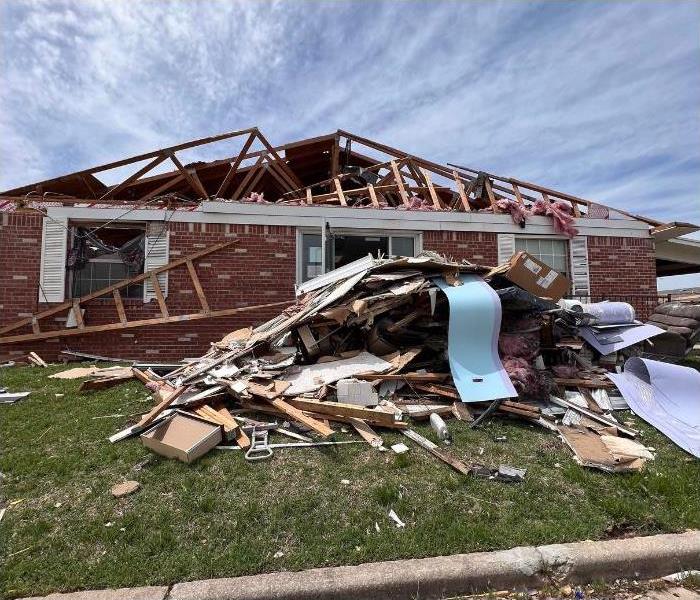 SERVPRO® of Central Oklahoma C is Here to Help, even on weekends. Our team of experts is on call 24/7 to respond to any emergency, no matter the size.
SERVPRO® of Central Oklahoma C is Here to Help, even on weekends. Our team of experts is on call 24/7 to respond to any emergency, no matter the size.
It’s been a tough year for everyone, and natural disasters have taken a toll on many homes. If your home has been affected by a severe storms, tornado, or another disaster, you may be wondering how to restore it to its former glory. Luckily, there are some SERVPRO® of Central Oklahoma City steps you can take to get your home back in shape. In this blog post, we’ll share some tips on how to restore your home after a natural disaster. Whether you’re dealing with water damage, wind damage, or something else, these tips will help you get your home back to normal. So if you’re ready to start the restoration process, read on!
The first step is to assess the damage. Take a look around your home and make a list of all the damaged items. Once you have a list, you can start to prioritize which repairs need to be made first. If there is structural damage, this should be your first priority. Structural damage is any damage that affects the load-bearing components of a home, such as the foundation, walls, ceilings, and/or roof. This type of damage can make a home unsafe to live in and can be very costly to repair.
In addition, if there is water damage, you will need to dry out your home and remove any mold or mildew that has formed. Water can enter your home through holes or cracks in the foundation, windows, or doors; through the roof; or from rising floodwaters. Once inside, water can damage floors, walls, furniture, and personal belongings. It can also lead to mold growth, which can pose serious health risks.
Once you have assessed the damage, it’s time to start cleaning up. First, make a plan of action. Write down what needs to be done and in what order. This will help you stay organized and avoid overlooking any important tasks. Then start with the basics. Begin by cleaning up any debris that may be inside or outside your home. This includes broken glass, downed tree limbs, etc. Finally, move on to bigger tasks next. If there is water damage, start by drying out the affected areas. Then, you can begin to repair any damage that has been done.
After you have cleaned up the debris and repaired any damage, it’s time to start thinking about prevention. Take a look at your home and identify any areas that are vulnerable to future disasters. Make sure you have strong doors and windows and consider installing storm shutters or hurricane straps. For example, storm shutters are one of the most important things you can do to protect your home from damage during a severe storm. They can be made from a variety of materials, but the most common type is metal. Taking these precautions will help you avoid future damage and make your home safer in the event of another disaster.
Restoring your home after a natural disaster can be daunting, but it is possible with the help of SERVPRO® Of Central Oklahoma City. We have years of experience helping homeowners recover from storms, floods, and fires. Contact us today, and we will get started on restoring your home to its original condition.
Affordable Ways To Prepare Your Home for the Storm Season
3/30/2023 (Permalink)
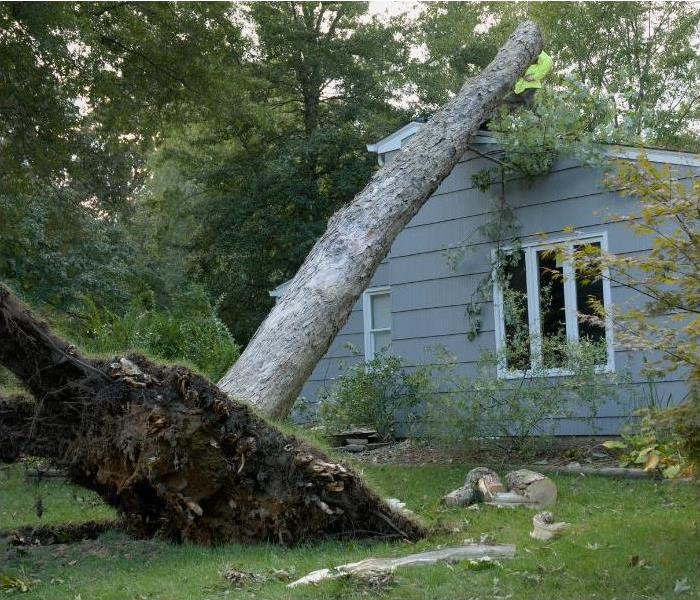 SERVPRO® of Central Oklahoma City is close by and ready to respond to storm and disaster events
SERVPRO® of Central Oklahoma City is close by and ready to respond to storm and disaster events
With tornado season upon us again, it’s high time to review some helpful SERVPRO of Central Oklahoma City tips on home storm preparation. Your house is probably your biggest investment; ensuring you have preventative measures in place as we enter the storm season can go a long way to protecting your home from the damage brought about by natural disasters. Without further ado, here are SERVPRO’s eight practical and affordable ways to prepare your home for the storm season:
Clean Your Gutters And Drains
The first places you may want to look at during your storm preparation process are your gutters, downspouts and drains. They play a crucial role in directing rainwater from your roof and away from your house, so it’s essential to ensure they’re free from leaves, debris, and other obstructions. A visual inspection of these roofing components before a storm can help put your mind at ease, knowing that you’ve done your due diligence in fending off roof leaks and basement flooding.
Conduct the Necessary Roof Repairs
It’s best to enlist roof repairs and maintenance regularly to ensure your roof remains stable and in good condition. Getting the cracked or missing shingles on your roof repaired before upcoming storms can help you prevent wind and water from getting through the structure and wreaking havoc inside your home.
Create Your Emergency Supply Kit
A major storm can easily cut off the power and water supply in your area. On top of that, roads can also become flooded or blocked. While no one wants to think these situations can happen to them, it’s better to be safe than sorry. Stocking up on necessities that can last for at least three days is a smart move and must be at the top of your home storm preparation tips. This will help you be more comfortable with the essentials while the storm rages on outside.
Items to stock up on should include:
- Non-perishable food and bottled water
- First-aid kits, emergency medical supplies, and other necessary medications
- Flashlights with spare batteries
- Blankets
- Clothing and toiletries
- Essentials for your pet
Aside from these essentials, you may also add your personal identification and cash to your emergency kit. Important documents such as birth certificates, marriage licenses, wills, insurance policies and other files must be stored in secure storage, like a safety deposit box in your home.
Protect Your Windows
Your glass windows are among the most vulnerable parts of your home, especially in extreme natural disasters like tornadoes. High winds and flying heavy debris can not only send shattered glass flying everywhere but also introduce extensive and expensive damage to your interior.
Nailing pieces of plywood to the outside window frames is an affordable way to protect your windows from flying debris — and yourself from pieces of broken glass. Many property restoration companies can perform this service for you so you don’t have to keep a stock of plywood during storm season.
Cover Your Air Conditioner
During a storm, your outdoor air conditioning unit will be exposed to high winds, heavy rains, and airborne projectiles that can enter it and cause all kinds of damage. An easy and effective solution for this is to invest in a manufacturer-approved protective cover.
Avoiding tarps, garbage bags, and other DIY solutions and getting the proper material may seem pricey at first. However, it’s a worthwhile investment that effectively wards off unwanted debris and moisture that can negatively affect your unit.
Clear Your Yard
Another affordable home storm preparation tip you can follow right now is to clear your yard of anything that can be blown around during the storm. Patio furniture, grills, potted plants, bikes, and other items must be moved indoors. On the other hand, outdoor sculptures like garden gnomes can be secured using burlap or ropes.
While you’re at it, having nearby trees and shrubs evaluated and trimmed is also a good idea. Strong winds can dislodge branches, uproot healthy trees, and cause larger accidents, so securing the surrounding greenery increases the chances of your home — and your trees — surviving the storm.
Listen to the Authorities
The authorities and weather institutions are there to ensure your health and safety, so it’s always best to listen to and take their suggestions seriously, especially when they’re telling you to evacuate. Trying to protect your property by staying home is not worth risking your life.
If you need to evacuate, unplug all appliances, turn off your utilities, and grab only what you need.
If you’ve not been asked to evacuate, listen to updates about the hurricane or storm on the radio, TV, or internet. It’s also recommended to stay inside and away from windows to avoid injuries from broken glass or flying debris. Ultimately, have your emergency supply kit easily accessible so you can leave anytime, especially if you have been ordered to evacuate.
Getting Back to Normal
It’s never easy to prepare for (let alone imagine) overwhelming property damage after a catastrophic storm. However, anticipating the worst-case scenario will help you and your family pave the way to getting back to normal, no matter what happens after the disaster.
Once you have checked off all the home storm preparation tasks listed above, it’s time to plan ahead by identifying the professionals you might need to contact once the storm has passed. For example, knowing a reputable storm recovery team in your area can give you peace of mind knowing you have someone who can help you get things back to normal.
Facing a major storm can leave you feeling worried about your property and your loved ones’ safety. And while these natural disasters can’t be prevented, following the storm preparation tips above can significantly minimize the blows your home will receive. But more importantly, knowing who to turn to after a disaster grants you the assurance that no matter what tomorrow brings, you can get the help you need to restore your property.
If you’re looking for 24/7 flood damage cleanup and storm recovery for your home or business, don’t hesitate to call SERVPRO of Central Oklahoma City now. Our experts are here to make this disaster feel like it never even happened.
SERVPRO Storm Disaster Process
1/26/2023 (Permalink)
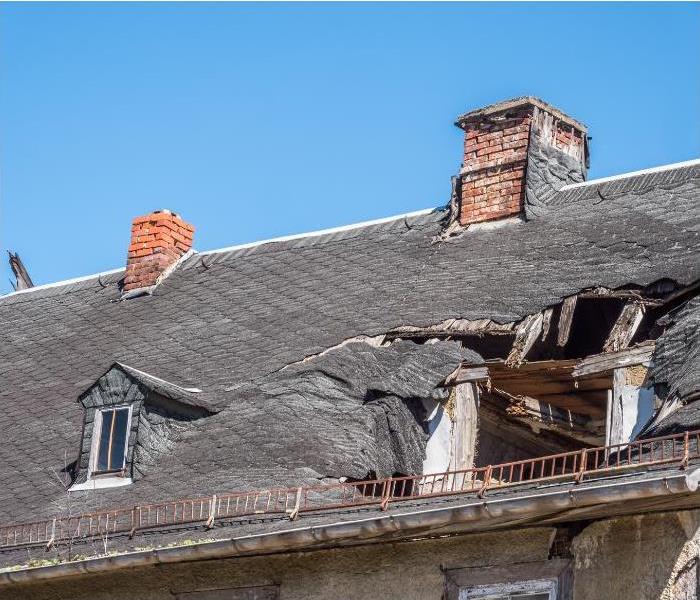 A residential property damaged by a bad storm
A residential property damaged by a bad storm
The first 24 hours following a water loss are the most important in preventing secondary or permanent damage. Within four hours of loss notification, SERVPRO of Central Oklahoma City will have a Professional on-site to help ensure the water damage is handled by completing the following steps.
We will inspect affected areas to determine the extent of water damage and will review the inspection with you to answer any questions before beginning any work.
Then we will take steps to help protect your home or business, as well as personal belongings and other contents, from further damage by extracting the excess water and preparing the area for drying. They will explain the needed emergency services to you step-by-step
To help ensure your home or business
and belongings are dried to appropriate
industry standards, we will monitor the drying process. The updates will be
consistently communicated to you.
Lastly we will repair structural materials, reinstall carpets, and clean affected areas of your property and belongings. A final walk-through of the job-site will be conducted
with you to help ensure the property was returned to pre loss condition.
Protecting Your Home During Storm Season
1/24/2023 (Permalink)
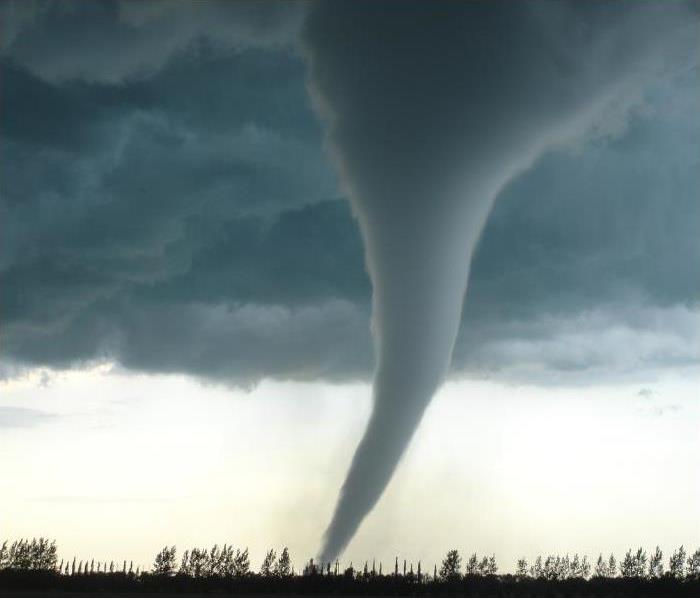 tornado
tornado
SERVPRO of Oklahoma City are no stranger to thunderstorms, hail, tornadoes, and strong winds. Tornado season is really all year in Oklahoma, but a peak does occur late March through August. This is when the prime conditions for tornadoes are met in Oklahoma. AccuWeather has predicted that there will be a five percent increase in the number of tornadoes that touch down in Oklahoma this, which could mean anywhere from 1,350 to 1,450 tornadoes. Tornadoes and the other acclimate weather associated with them mean that areas all over Oklahoma are at an increased risk of facing severe weather events during this period of time. Here is a list of preventive measures Oklahoman home and business owners can take to protect themselves and their properties against the challenging weather ahead:
-Keep the trees and branches near your home trimmed. This will make them more resistant to wind. Excess water can weigh down smaller and/or weaker branches, causing them to break off at a higher rate than larger branches. Take this into account when maintain your foliage.
-Secure fences and outdoor furniture. Heavy winds often accompany storm season. Protect the exterior of your home by ensuring that anything that could potentially turn into flying debris during acclimate weather is properly secured or stored.
-Protect critical areas. Storms and winds are a major threat to doors, roofs, and windows. The installation of temporary protection during a stretch of time where acclimate weather is predicted to occur again and again can prove to be incredibly beneficial to both business and home owners. SERVPRO of Central Oklahoma City is happy to provide board up services to both commercial and residential properties.
-Check your gutters. Be sure to clear your gutters of any debris and to ascertain that your downspouts are draining away from your home. Buildup in your gutters can cause storm water to overflow which cause both internal and external damage to your property.
It is our sincere hope that these tips will help to protect your home or business during storm season. In the event that your home is affected by storms, fires, leaks, flooding, mold, or any other sort of undesirable incident SERVPRO of Central Oklahoma City offers reconstruction and restoration services to help you manage the damage and make it "Like it never even happened."
WHAT HAPPENS DURING STORM DAMAGE RESTORATION
9/29/2022 (Permalink)
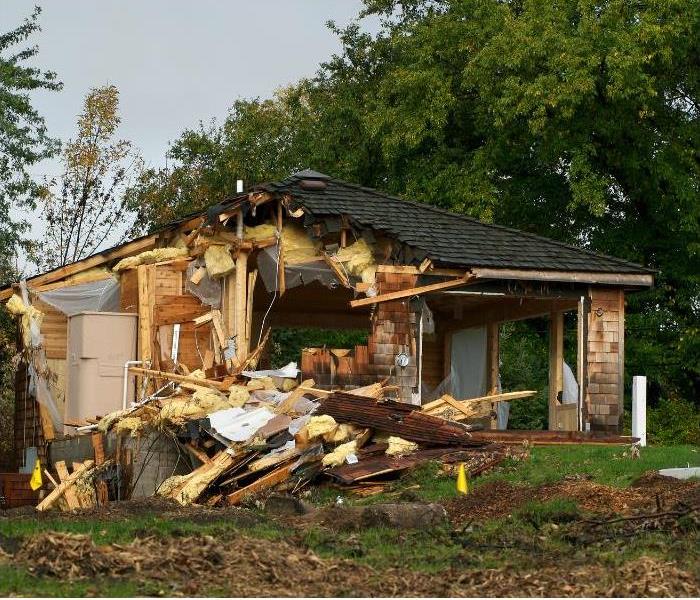 Storm damage house
Storm damage house
Step One: Ensure everyone is safe
Severe storms can leave behind broken, disintegrated glass, roofs, ceilings, windows, and other hazards. It is critical that the first priority following a hurricane is ensuring that everyone is safe.
Generally, it’s your first time inspecting the property to assess the storm’s damage. While this is important, there are more critical precautions you must conduct.
First, confirm that there’s no threat of electrocution. This is more likely if flooding has occurred and down power lines are close to the property. If this is the case, stay away from the property until the power is cut.
If your roof appears unstable, evacuate from the house until professionals can inspect the structure. Actively watch out for things such as nails, sharp debris, and glass.
Most importantly, if the house smells of natural gas after the storm, notify the gas company immediately.
Ensuring everyone’s safety will always SERVPRO®? of Central Oklahoma City be the number one step that is a non-negotiable act after a storm’s passing.
Step Two: Guard the property
After taking the necessary safety precautions, your second step is to guard and secure the property.
Check for any broken windows, heavy leaks, and flooding. Board up any window that is still letting water in. Remove any valuable possessions that might be at risk. Remember, stagnant water is notorious for causing more severe problems. Also, water intrusion can lead to mold growth which can be life-threatening.
This step is overwhelming for most people. Reaching out to SERVPRO®? of Central Oklahoma City storm restoration team is your best option.
Step Three: Documentation of all storm damages
After ensuring everyone is safe and the property is guarded, assessing the damage is the next step to storm damage restoration. This can be an emotional process but is vital for filing an insurance claim.
It is essential that documentation of all the storm’s damages is thorough. Taking pictures of both the exterior and interior of the property helps. Every photograph must be detailed.
If there are any major appliances or furniture that is broken, photograph them to help determine the replacement value. Documenting every damage to a property will make the insurance claims process more straightforward.
It is also vital to carefully inspect the property’s exterior as many damages can go unnoticed. Look for damage residing on roof shingles, siding, window frames, and outdoor HVAC units.
The documentation process may seem like a hassle and unnecessary, or even stressful, but it must be done to recover the correct amount of losses acquired.
Step Four: Partner with SERVPRO®? of Central Oklahoma City
Dealing with storm aftermath is challenging, not to mention the complicated procedure of processing your claims. When you hire SERVPRO®? of Central Oklahoma City we will assist the property’s damages accurately and aid in getting the property back to normal.
Working with a company with a strong reputation and positive public image is important. Ensure the organization has extensive knowledge regarding handling all types of damages that can arise because of a storm.
TIPS FOR PREVENTING WIND DAMAGE TO YOUR HOME
9/29/2022 (Permalink)
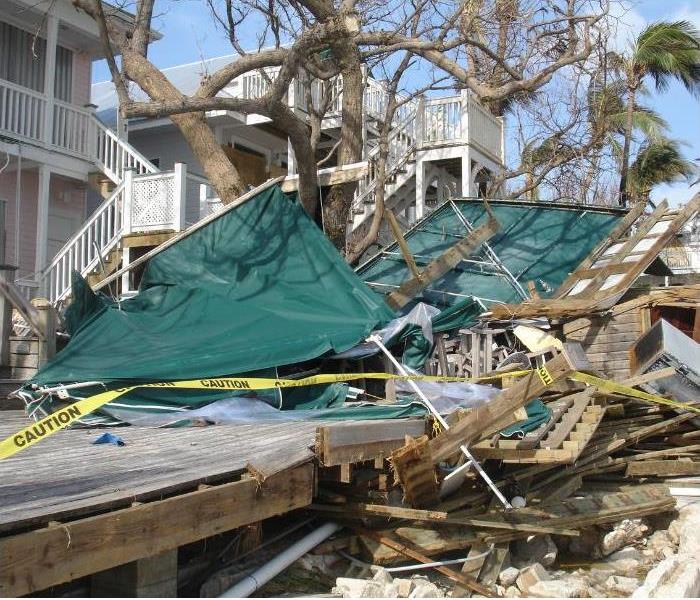 Storm damage to house
Storm damage to house
CLEAR THE AREA OF ANY DEBRIS
Except for extreme cases, wind by itself is not all that dangerous to your home. The trouble comes when it blows any surrounding debris into the side of your house. Things such as rotting trees, branches, or even gravel can destroy your property if you are not careful. Removing these items from the area is an excellent way to nip any future problems in the bud.
You may be hesitant to do this as removing trees from a property consumes both time and money; however, leaving it and putting your home at risk create the possibility of a bigger problem. Unfortunately, many homeowners fail to recognize this and end up dealing with the expensive damages left behind by the tree’s limbs.
REINFORCE THE DIFFERENT AREAS OF YOUR HOME
Storm shutters are an addition that you can add to your home’s windows to increase their durability. This added resistance protects your home and the people living inside it from wind-borne debris. On top of storm shutters, you have the additional option of adding shatter-resistant film or high- impact glass to your windows.
Your doors are another area of your home that can easily succumb to wind pressure. Reinforcing these with a heavy-duty deadbolt, stronger hinge attachments, and slide bolts can drastically reduce the chances of their destruction.
Your roof is one of the most important defenses when it comes to a wind storm. Fortifying it and taking care of any loose shingles is one way to keep your roof prepared for high winds. Another option is to change out your regular shingles altogether for impact-resistant shingles.
SEAL GAPS IN YOUR HOME
Sealing off the gaps and cracks in your home removes its vulnerability. These entry points allow wind and water to enter you home, creating many other issues. Resealing the areas around your windows and doors with caulk will help prevent flooding and mold issues exacerbated by winds.
WHAT IS OUR MISSION?
SERVPRO®? of Central Oklahoma City is here to assess your storm damage and determine the next steps towards repairs to make this disaster feel “Like It Never Even Happened.” If you need a roofing evaluation or have suffered exterior damage due to storms or other natural disasters contact us and schedule a storm damage evaluation and start on the road to recovery.
Winter Storm Safety Tips for Your Family
1/3/2022 (Permalink)
While your home can be damaged due to winter weather and extreme cold, your personal health is also at risk. Fifty-three people died and three were injured due to extreme cold in 2015. It is important to be aware of the effect extremely cold temperatures can have on you. The two main conditions to be aware of are frostbite and hypothermia. Frostbite is caused when your skin is exposed to extremely cold temperatures. Physical symptoms are white or grayish-yellow skin, skin that feels unusually firm, or waxy numbness. Hypothermia occurs when your body temperature falls to an abnormally low temperature, caused from long exposure to cold weather. Signs of hypothermia include shivering, exhaustion, confusion, fumbling hands, memory loss, slurred speech, and drowsiness. If someone’s body temperature is below 95°F, seek medical attention immediately. To avoid these conditions, stay indoors if possible. If not, dress warm in layers and try to keep dry.
Source: ready.gov/winter-weather
Protect Yourself from CO When Winter Storms Happen
1/3/2022 (Permalink)
Carbon monoxide is a gas you cannot see, taste or smell. According to ready.gov, an average of 430 Americans die each year from unintentional carbon monoxide (CO) poisoning. Often times, it is the result of faulty, improperly used/vented consumer products like furnaces, ranges, water heaters, room heaters, and engine-powered equipment (such as portable generators). However, there are precautions you can take to help protect yourself, your family, and your employees from deadly CO fumes. Reduce the chance of CO exposure in your home by performing regular maintenance on equipment and appliances that can produce CO. Install carbon monoxide detectors on every level of the home, including outside of all bedrooms. Consider having all fuel burning heating equipment and chimneys serviced annually by a professional. Use portable generators only in well ventilated areas away from doors, windows, vents, and any other openings to prevent fumes from entering the home.
For additional CO safety information, visit usfa.fema.gov or osha.gov.
Lightning Fast Facts for Oklahoma City Residents
7/23/2021 (Permalink)
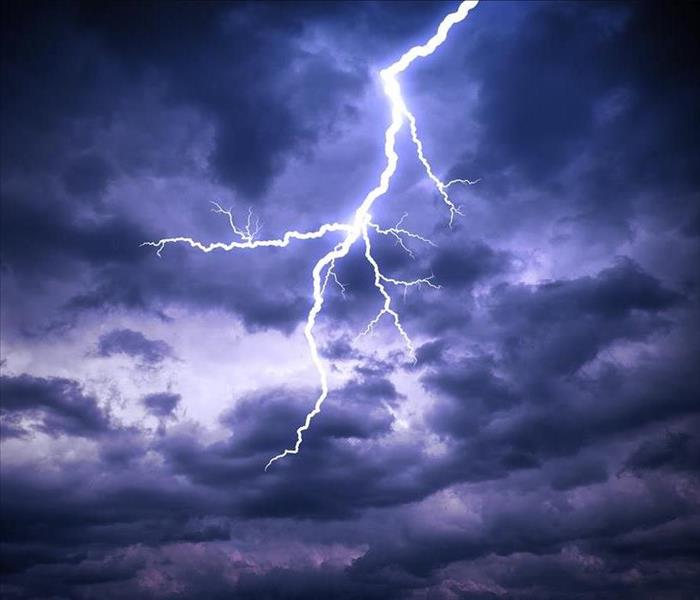 Lightning strikes are no laughing matter, and as always it's important to know what we're dealing with.
Lightning strikes are no laughing matter, and as always it's important to know what we're dealing with.
As one of the leading weather-related causes of death or injury in the nation, lighting deserves to be understood better so we can be both awed and avoidant of it.
At SERVPRO® of Central Oklahoma City, we strive to be knowledgeable, proactive and preventative in approaching the stormy seasons of Oklahoma.
Here are some flash facts about lightning:
- While the speed of light (when we see the bolt) is 670,000,000 mph, the actual speed of a strike is only 27,000 mph. Need help visualizing this? Imagine traveling to the moon in only 55 minutes.
- Everyday, there are over 3 million flashes of lightning (about 44 strikes each second). The earth is struck by lightning more than 100 bolts each second.
- Lightning can help plants grow through creating nitrogen oxides by its heat and combining with moisture to provide nitrate-rich water for plants.
- The width of a bolt is only about 2 to 3 centimeters (about the size of a thumb) but it spans a length of about 2 to 3 miles.
- Lightning can reach up to 50,000°F, which is about 5x hotter than the sun’s surface.
- Thunderstorms aren’t the only source of lightning; it can be found in volcanic eruptions, forest fires, nuclear detonations, snowstorms and hurricanes.
- Using surge protectors won’t actually protect your appliances against direct strikes, so make sure to unplug all of your equipment.
- Using the phone while indoors is actually the leading cause of injuries by lightning within a household.
- You can easily be struck by lightning even if the eye of the storm is 10 miles away.
Lightning isn’t something to mess with or worth taking any chances at the risk of death or injury. It must be taken seriously, but we can admire the beauty and nature of lightning without compromising our safety.
And should your home or commercial property incur any damage from a lightning strike or other severe weather event, we're on call 24/7 and faster to any disaster. Just give us a call at (405) 252-9400 and we'll be on our way.
What Do The Hurricane Categories Actually Mean?
7/12/2021 (Permalink)
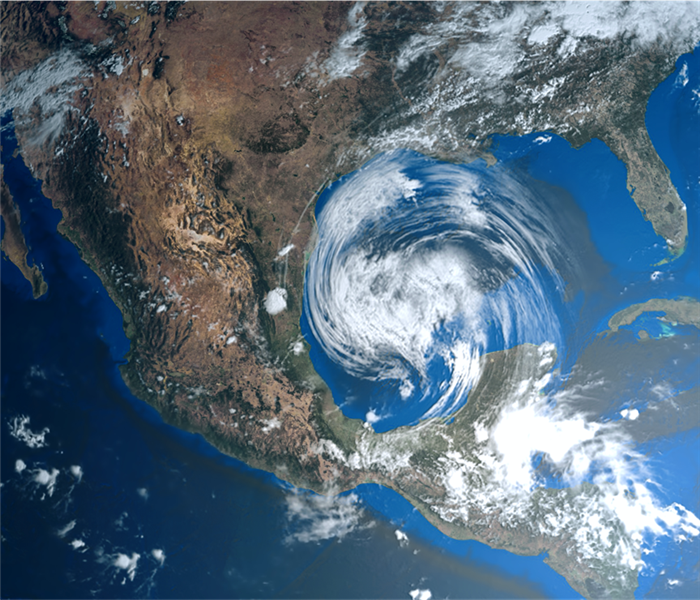 When it comes to severe weather events like hurricanes, it's always good to know what we're up against.
When it comes to severe weather events like hurricanes, it's always good to know what we're up against.
Hurricane season in Oklahoma typically begins around June 1 and lasts until November 30, with an increase in August and hitting its peak in September.
Hurricanes are categorized by the Saffir-Simpson Hurricane Wind Scale, which is rated 1 to 5 based on maximum ongoing wind speed. The scale was developed in the 70s by Herbert Saffir, an engineer in Miami, and Robert Simpson, a meteorologist and former director of the National Hurricane Center.
The scale doesn’t factor other hazards that result from hurricanes such as storm surges, flooding and tornadoes, but it does estimate the probable damage of property. Although category 3 or higher are known as major hurricanes, all categories have the ability to result in major damage.
At SERVPRO of Central Oklahoma City, we’re committed to understanding the storms our communities are enduring and finding practical solutions and preventative measures for each scenario. Here’s a rundown of the different categories of hurricanes to watch out for:
CATEGORY 1 — Winds are 74 to 95 mph
Winds are considered very dangerous and expected to produce some damage. Homes with well-structured frames might suffer roof damage, large tree branches could snap or trees with shallow roots may fall over. If power lines or poles are damaged, it could result in power outages lasting up to several days.
CATEGORY 2 — Winds are 96 to 110 mph
Winds are considered extremely dangerous and expected to cause extensive damage. Houses may endure major roof damage and trees could easily snap or be uprooted, blocking roads. It is expected for an almost total power outage to occur and last up to a few weeks.
CATEGORY 3 — Winds are 111 to 129 mph
Winds are expected to cause devastating damage. Framed homes will suffer major roof damage including removal of parts of the roof. Trees are easily snapped and uprooted, blocking major roads. Electricity and water expected to be unavailable up to several weeks post-storm.
CATEGORY 4 — Winds are 130 to 156 mph
Winds are expected to cause catastrophic damage. Houses will experience severe damage including a loss of the majority of the roof structure as well as exterior walls. Trees will be snapped and uprooted along with power poles, isolating areas in the community. Power outages can last up to months and the area will remain uninhabitable for weeks to months.
CATEGORY 5 — Winds are 157 mph or more
Severe winds are expected to cause catastrophic damage as well. Houses will be destroyed, including total roof failure and collapse of walls or structure. Trees and power poles that have fallen will isolate communities. Outages are expected to last for weeks or months as well as the area being uninhabitable for quite some time.
SERVPRO of Central OKC hopes to serve the community by providing this knowledge for people to understand and take action in protecting them against potential storms. The best thing to do to protect yourself and your loved ones is evacuate these areas vulnerable to dangerous storms.
How to Prepare For Summer Power Outages
6/30/2021 (Permalink)
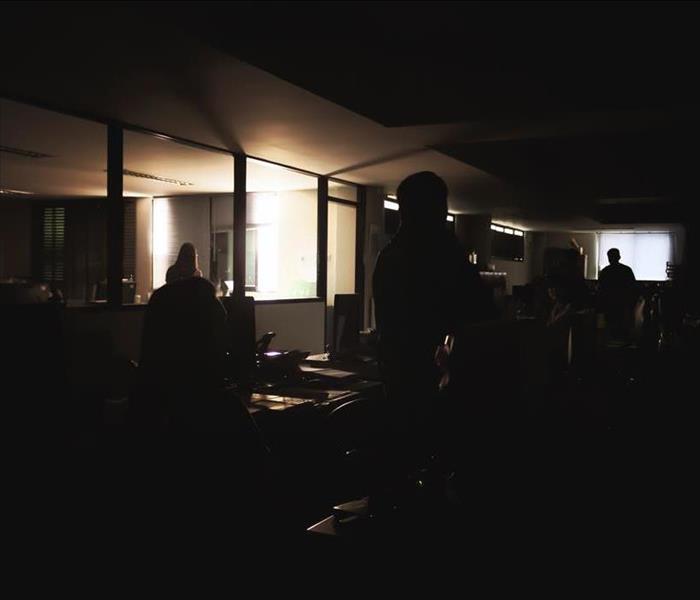 When summer brings about power outages, it's good to stay prepared.
When summer brings about power outages, it's good to stay prepared.
As we continue our trek into the iconically hot summers of Oklahoma, we remember that the risk of a summertime power outage comes with the benefits of vacation time and poolside rendezvous.
In light of this, we must be prepared to safeguard against these summer power outages so we can try our best to enjoy the cool air all summer long.
Spotting a Brownout
When the weather conditions are severe, electric companies often implement a brownout — a reduction of electricity in a specific area — to keep from overloading the power grid. You can catch these signs by observing your lights and electric appliances to see if they are flickering or turning on and off rapidly. There may also be power interruptions intermittently. Make sure to turn them off so you can protect your appliances from this abnormal voltage as they can easily be damaged.
What To Do
If you suspect a power outage could be coming your way eventually, take these precautions to avoid the situation altogether:
- Try to keep the thermostat at 78 degrees or higher, if possible
- Keep lights and pool pumps off
- Limit your use of large appliances like ovens, washing machines and dryers
- Turn off and unplug devices that aren’t currently being used
When It Happens
Sometimes we aren’t so quick to avoid power outages, and sometimes, even though we have exhausted all of our options and best practices, we still experience them. In this case, there are some things we can do to prioritize our safety and comfort and sustain our possessions:
- Call your electricity company immediately. Report the outage and stay patient as they’re probably working as quickly as they can to fix the issue.
- Keep the fridge and freezer closed so the inside stays cold. A full freezer, without being opened, can keep food frozen for about two days. If half-full, the food only lasts a day. The fridge will keep food good for 4 hours if unopened.
- Don’t open the windows and doors. It’s tempting to keep from feeling trapped inside but opening the doors and windows will only let the outside air come in, making it much hotter. Also, close the blinds and curtains on the sunny side of your property to keep the home from overheating.
- Use a surge suppressor. This can be purchased at any local hardware store and will protect your devices and electronics from getting fried when the power comes back on.
Whether you are pre- or post- power outage, it’s best to be prepared for the next (or first) potential one. Consider getting a backup generator or stock up on battery-powered fans and other necessities.
Summer power outages may be inevitable but we can do our best to lessen the negative effects on our households.
Have more questions? Call your neighbors at SERVPRO of Central Oklahoma City: (405) 252-9400.
What to Expect This Hurricane Season
6/1/2021 (Permalink)
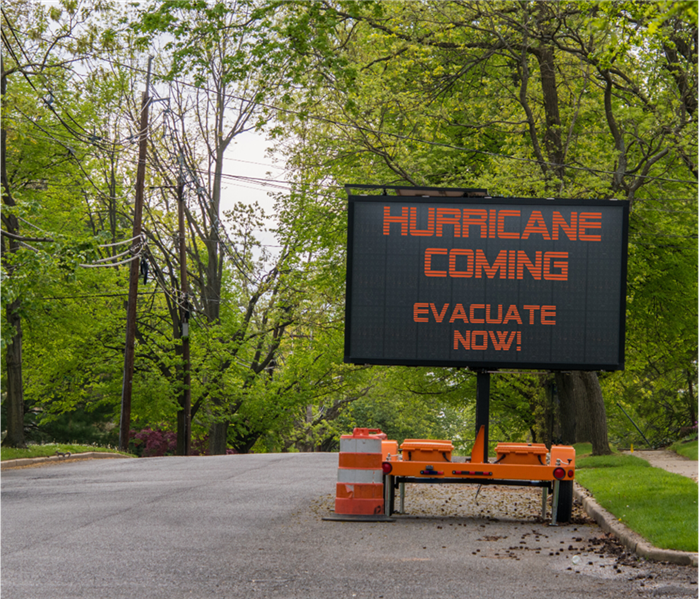 Stay one step ahead of hurricane season with some helpful info from your neighborhood restoration experts.
Stay one step ahead of hurricane season with some helpful info from your neighborhood restoration experts.
Summer has arrived in Oklahoma, which means hurricane season is officially in full swing. And after last year broke records for number of storms (according to The Farmer’s Almanac and the Department of Atmospheric Science at Colorado State University), another active hurricane season is anticipated in 2021.
Scientists anticipate 17 named storms in 2021, eight of which are categorized as hurricanes. These numbers are based on forecasts from April 2021 that are subsequently updated throughout hurricane season through the end of August. Since 1981, the average number of hurricanes per season is 6.4, meaning this summer is likely to continue a recent trend of above-normal storm seasons in the USA.
In 2020, much of the hurricane-caused flooding in the U.S. occurred in Louisiana, Texas, and other gulf states. However, hurricanes can persist as severe storms as they make further landfall into inland Texas and Oklahoma.
You already know that SERVPRO is faster to any disaster, and that no matter the storm damage our restoration experts can make it "Like it never even happened." But the more you know about hurricanes, the better you can prepare before they hit.
Here are a few hurricane facts that could come in handy this summer:
What Criteria Qualify a Hurricane
A hurricane is a tropical storm with winds that are at least 74 mph. They’re usually weakened when they make landfall, which is why states bordering large bodies of water (like the Atlantic Ocean or Gulf of Mexico) are often the most impacted. However, even if after making landfall it falls below the threshold of an active hurricane, it can still cause wind damage and flooding from the intense rain that persists.
There Are Different Classes of Hurricanes
Hurricanes can be classified from 1-5 depending on the speed of wind of that particular storm. A Class 1 hurricane ranges from 74-95 mph, while a class 5 hurricane is a storm with 156+ mph winds. The last class 5 hurricane to make landfall in the United States was Hurricane Maria in 2017.
How Meteorologists Predict Hurricanes
Thanks to modern satellite technology, meteorologists are able to identify and track hurricanes that develop and travel more easily than ever. Hurricanes usually take a few days (or even more than a week) to fully develop and ultimately make landfall. That’s why it’s vital to heed hurricane warnings if a storm threatens our area!
And, as always, call us 24/7 for expert advice or to have a team of specialists dispatched to your home or commercial property: (405) 252-9400.
Tips for Summer Storm Preparedness
5/4/2021 (Permalink)
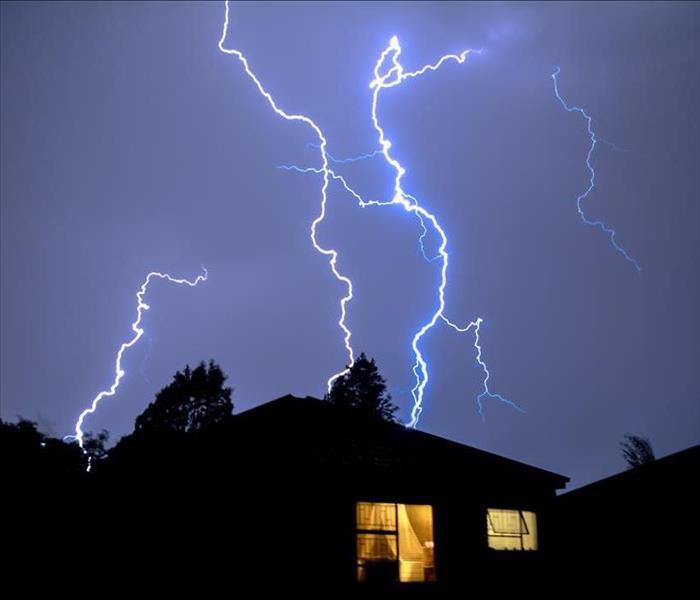 Although we can't prevent a storm from happening, there are ways to prepare and increase safety when they do.
Although we can't prevent a storm from happening, there are ways to prepare and increase safety when they do.
Summer is the height of storm season in Oklahoma, and with it comes, of course, a greater risk of storm damage to your home or commercial property.
You already know that if your property floods, is struck by lightning, or sustains any other kind of wind or storm damage, that the experts at SERVPRO of Central Oklahoma City are faster to any disaster. But what can you do to protect yourself and your property as a storm is approaching?
Here are a few tips:
Get To Lower Ground
If a storm is approaching that promises to bring strong wind and even the possibility of a tornado, it is wise to avoid higher stories of your home or property. If you have a basement, that is an optimal place in which to wait out a storm.
If not, try and find a place on the ground floor of the building, ideally in an interior room that has limited, if any, windows to the outside. This reduces the risk of broken glass injuring someone inside the property.
Have Supplies Handy
It’s not uncommon for a severe summer storm to knock out power for an unknown amount of time. That’s why it’s important to have supplies like a flashlight and extra batteries handy before a storm arrives so you can be prepared for whatever comes next.
Try and avoid relocating immediately before (or during) a storm, as not only will rain impact visibility but high winds and lightning strikes can be the downfall of even the most defensive drivers.
Try to Unplug
Even if you don’t lose power, lightning strikes can cause power surges, so try and unplug non-essential electronics that you’re not using as a storm bears down on your property to reduce the risk of a surge or even an electrical fire. This can include anything from spare televisions not in use to kitchen appliances to unused phone chargers or gaming consoles. Unless it’s essential, it’s not a bad idea to unplug it.
Contact Us
And, again, should a storm do damage to your home or commercial property, call our team at (405) 252-9400 and a team of SERVPRO specialists will make it "Like it never even happened."
Protect Your Home By Protecting Your Roof From Wind Damage
1/15/2021 (Permalink)
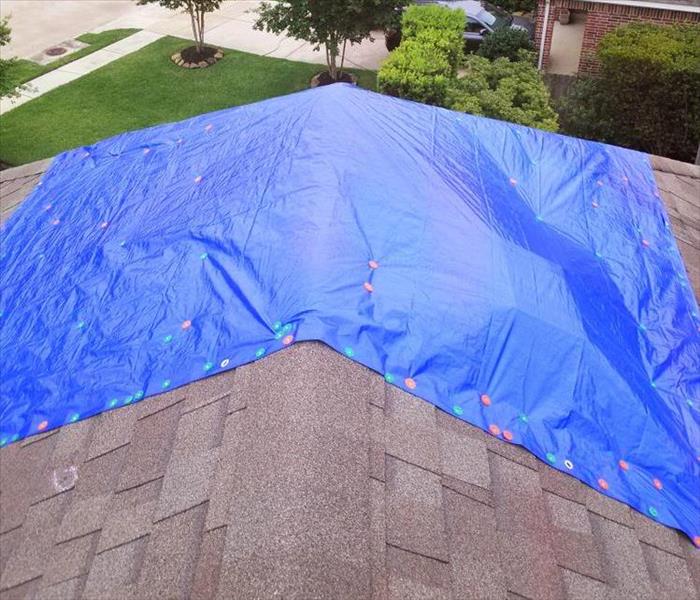 When roof damage happens, it is crucial to protect your home with tarping
When roof damage happens, it is crucial to protect your home with tarping
A roof is a vital protective feature of your home in Warr Acres, OK, but you lose that protection when strong winds cause roof damage. These are some features of a roof that can determine wind damage and tips for preventing it.
Factors Contributing To Damage
Protecting your home's roof means understanding its vulnerabilities, which may include:
- Construction materials
- Construction quality
- Age
- Shape
- Slope
Some materials are better suited to withstand the elements than others. For example, slate roofs are significantly more durable than asphalt roofs, though roofs over twenty years old should have routine inspections for hidden damage that could worsen after a storm.
When wind hits your home's sides, it starts to move upward, creating pressure as it goes, until it reaches the edges of your roof, where it exerts a maximum force. It then travels along your roof's surface, where it creates a suction-like pull against roof materials that can be strong enough to loosen or dislodge shingles. Sound construction can help a roof withstand these forces. Roof damage is also avoidable when roofs consist of multiple panels having 30-degree slopes.
How To Prevent and Reduce Damage
Routine roof inspections are critical for protecting your roof from wind damage. Scheduling inspections during mild seasons can ensure that you have plenty of time to perform repairs before severe weather hits.
Wind can also indirectly damage your home if it carries debris that it deposits on your roof. The weight of tree limbs and other objects, including laws furniture that strong winds are capable of lifting to your rooftop, can puncture, crack and loosen shingles. Clearing objects and debris from the ground surrounding your home can help prevent them from landing on your roof during a storm.
Storm Recovery
When roof damage happens, it is crucial to protect your home with tarping and begin repairs as soon as possible. If a storm results in damage to your home's interior, you can count on a storm restoration service to handle the clean-up.
Here are Three Simple Tips for Maintaining Your Sump Pump
1/13/2021 (Permalink)
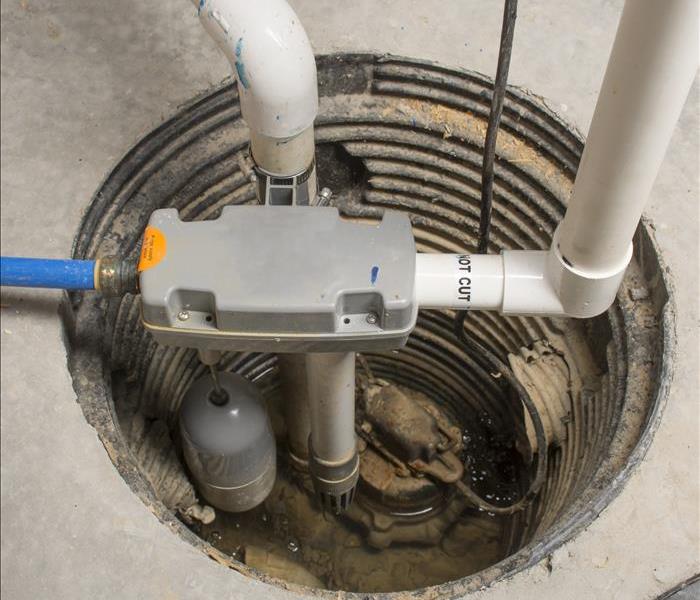 Sump pump system
Sump pump system
Here are Three Simple Tips for Maintaining Your Sump Pump
Many basements in Oklahoma City, OK, are installed below the top of the water table. Others are built in areas where storm water collects. Once water starts pooling around the foundation, it’s essential to remove the excess water before it can cause damage. Typically, the best way to do this is with a sump pump.
The sump system works automatically and in the background. They can last more than a decade without problems and are customized for your particular conditions. However, it does require pump maintenance for it to work seamlessly. Fortunately, just doing a few things a year will increase longevity and prevent problems:
- Quarterly or monthly screen cleaning
- Annual pump cleaning
- Annual Testing
Screen Cleaning Intervals Will Vary
The Sump and Sewage Pump Manufacturer's Association recommends cleaning the sump pump screen or inlet opening regularly. If you don’t have a washing machine, clean it every three or four months; if you do, clean it monthly.
Annual Cleaning Is Critical
Remove the pump and hand clean it. Clean out the sump pit, paying particular attention to sediment that’s collected. Also, clean the pump screen. If the water was oily, you may have to wipe the pit out. Also, check the sump discharge pipe for clogs and make sure it’s still draining in a good location.
Inspect the pump for rust or defects. Most pumps will not require lubrication, but each is different, so consult your manual. If you aren’t sure, you can contact local water damage restoration specialists who have experience with maintenance and cleanups that become necessary if the pump fails.
Testing Helps Prevent Catastrophic Failures
The float switch is what turns your pump on and off. It’s sensitive to debris, so it should be tested. Pour some water in and observe it while functioning. Does it move jerkily or bind? Does the pump start and stop smoothly and do so in time with the switch?
Identifying problems early helps prevent water damage and black mold from developing. When done correctly, your sump pump can mostly stay out of mind and out of trouble.
Protect Your Property From Lightning
9/9/2020 (Permalink)
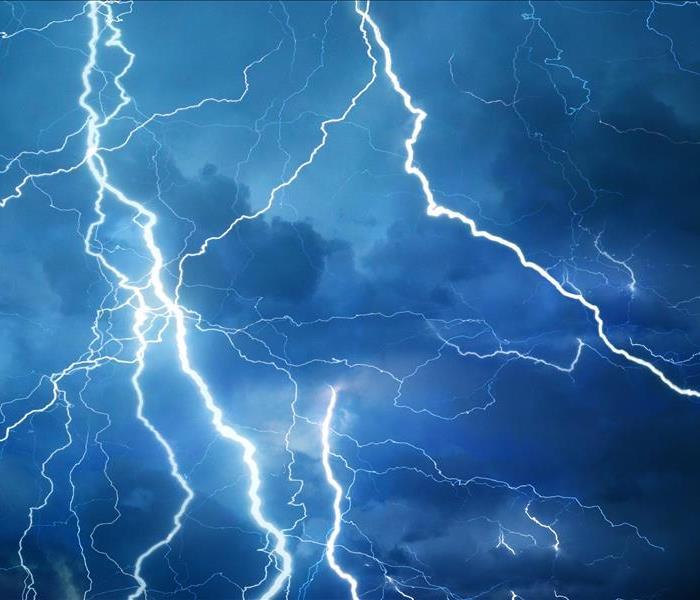 Lighting can damage your roof externally, or can cause internal damage to your home or business if the lightning starts a fire.
Lighting can damage your roof externally, or can cause internal damage to your home or business if the lightning starts a fire.
Severe thunderstorms can happen anytime if year in Oklahoma City. These storms often bring lightning along with them. Lightning causes buildings (both residential and commercial) billions of dollars in loss every year. Though you cannot do anything to stop the lightning itself, there are several precautionary measures you can take to protect your home or business against both the direct and indirect effects of lighting strikes.
Install a lightning-protection system. Standard homeowners insurance covers lightning related loss, but it is still a good idea to protect your property from the initial strike. If you live in an area that is often hit by thunder and lighting (such as Oklahoma City), you may receive a discount on your homeowners insurance if you install a lighting-protection system.
Call the fire department immediately, even if you do not see flames. If your house is struck by lighting, chances are there is fire somewhere in your house. Fire can “hide” in the attic or in the insides of your walls. Do not wait until you see flames, to call the fire department-call them immediately. This is will minimize potential damage.
Unplug your electrical items during storms. This will protect these valuable items from damaged in the rare event that your house is struck by lightning. Unplug computers and landline telephones first.
If lightning does strike, SERVPRO of Central Oklahoma City is here to help. Our team can help to restore your property and any affected belongings back to preloss condition!
Preparing Your Property for Tornado Season
9/9/2020 (Permalink)
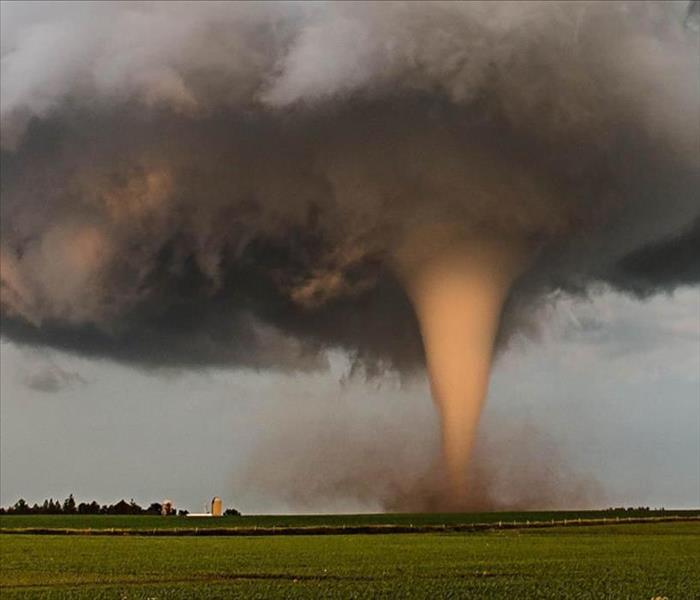 Oklahoma City residents live with the risk of tornadoes all year round.
Oklahoma City residents live with the risk of tornadoes all year round.
The threat of tornadoes loom over Oklahoma City year-round. There are several precautionary measures you can take to protect your property against tornadoes or even just the strong winds that are often seen in Oklahoma City.
Check your insurance coverage. Make sure that your insurance policy is up-to-date and comprehensive. You may want to assess your belongings and take an inventory of your items so that you have you a record of what you own in the case that something does happen to your home or business.
Secure high-risk items. High-risk items are those that have a high risk of falling over. This includes top heavy items such as tall cabinets or bookshelves. Secure them to the wall with heavy duty brackets or molding. Also secure large appliances which could easily become damaged or cause extensive damage to other parts of your property easily.
Protect the exterior of your property. Lessen the chance of water and wind entering your home by making sure that all roof shingles are secure, installing an impact resistant garage door, and/or installing shutters on your windows.
SERVPRO of Central Oklahoma City is here to help deal with any damage that tornadoes or storms may wreak on your home or business. But be sure to keep checking out our blogs for more tips on how to keep your property protected from both natural and unnatural disasters!
The Different Types of Weather Alerts
8/11/2020 (Permalink)
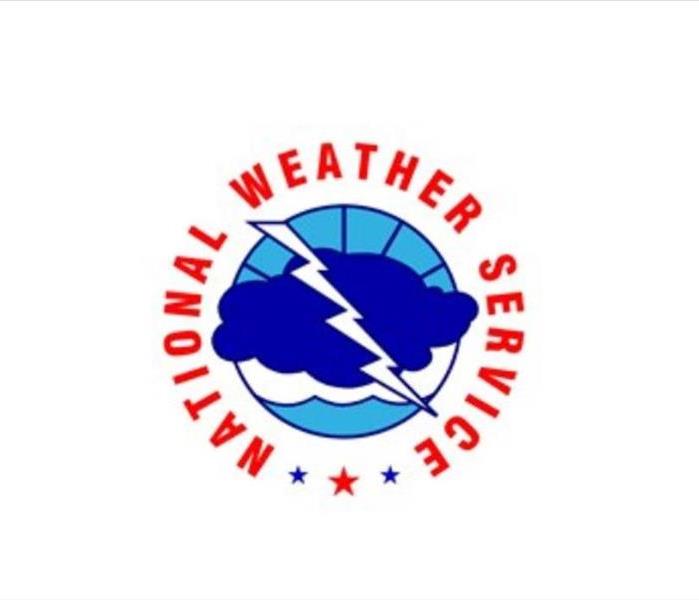 Official logo of the National Weather Service, which has been providing weather forecasts and alerts since 1870.
Official logo of the National Weather Service, which has been providing weather forecasts and alerts since 1870.
There are several types of severe weather that impact Oklahoma City and the surrounding areas that can cause the National Weather Service (NWS) to issue an alert. Alerts are issued in order to make the population of the impacted area aware of the potential dangers that they could be facing, and hopefully allow them time to adequately prepare for the impending acclimate conditions. There are several different types of alerts that can issued, varying in degree by the potential risk associated with that type of weather. The three most common classes of alerts issued by the NWS are watches, warnings, and advisories. Watches, warnings, and advisories can be triggered by a number of different types of weather phenomena, such as floods, thunderstorms, tornadoes, and even excessive heat. Below are the definitions of each alert to help you better understand the distinctions between them:
A watch is issued when there is chance this condition will occur, and generally covers a larger geographic area over a longer period of time.
A warning means that the weather is already occurring or has a high likelihood of occurring in the near future, and advises the population of the impacted area to take proper protective measures.
Advisories are issued when a certain type of weather has a fair chance of occurring, but advisories are typically used for less severe types of weather conditions (i.e. the issuance of a wind advisory rather than a high wind warning).
Now that you understand the differences between watches, warnings, and advisories here are the criteria for some of the issues that are most commonly issued for our region by the governing NWS office, which is located in Norman, OK:
Freezing Rain/ Drizzle Advisory Issued when freezing rain is predicted to cause travel problems, but not exceed an accumulation of ¼”.
Ice Storm Warning Issued when freezing rain is expected to produce ice accumulations of 1/4” or greater, and significantly disrupt traffic and utilities.
Severe Thunderstorm Warning This type of alert occurs when there is a reliable report that a thunderstorm is producing or will soon produce gusts of wind of 58 mph or greater, structural wind damage, and/or hail with a diameter of 1” or greater.
Flash Flood Watch Issued when an area is facing the possibility of flash flooding within the next 36 hours.
Flash Flood Warning Issued when a flash flood is predicted to occur in the next future, generally within the next 1 to 3 hours.
Hopefully knowing the difference between these weather alerts can help you adjust your expectations and better prepare for the occurrence of acclimate weather. SERVPRO of Central Oklahoma City is here to help you restore your home or business in the event that disaster does strike. Whether it was water damage caused by a flood or you are needing roof repairs after a hail storm, we will make it "Like it never even happened." Give us a call at (405)252-9400 or submit an information form and we will follow-up with you!
Sources:
https://www.weather.gov/oun/spotter-wwa-definitions
 SERVPRO® of Central Oklahoma C is Here to Help, even on weekends. Our team of experts is on call 24/7 to respond to any emergency, no matter the size.
SERVPRO® of Central Oklahoma C is Here to Help, even on weekends. Our team of experts is on call 24/7 to respond to any emergency, no matter the size.





 24/7 Emergency Service
24/7 Emergency Service














